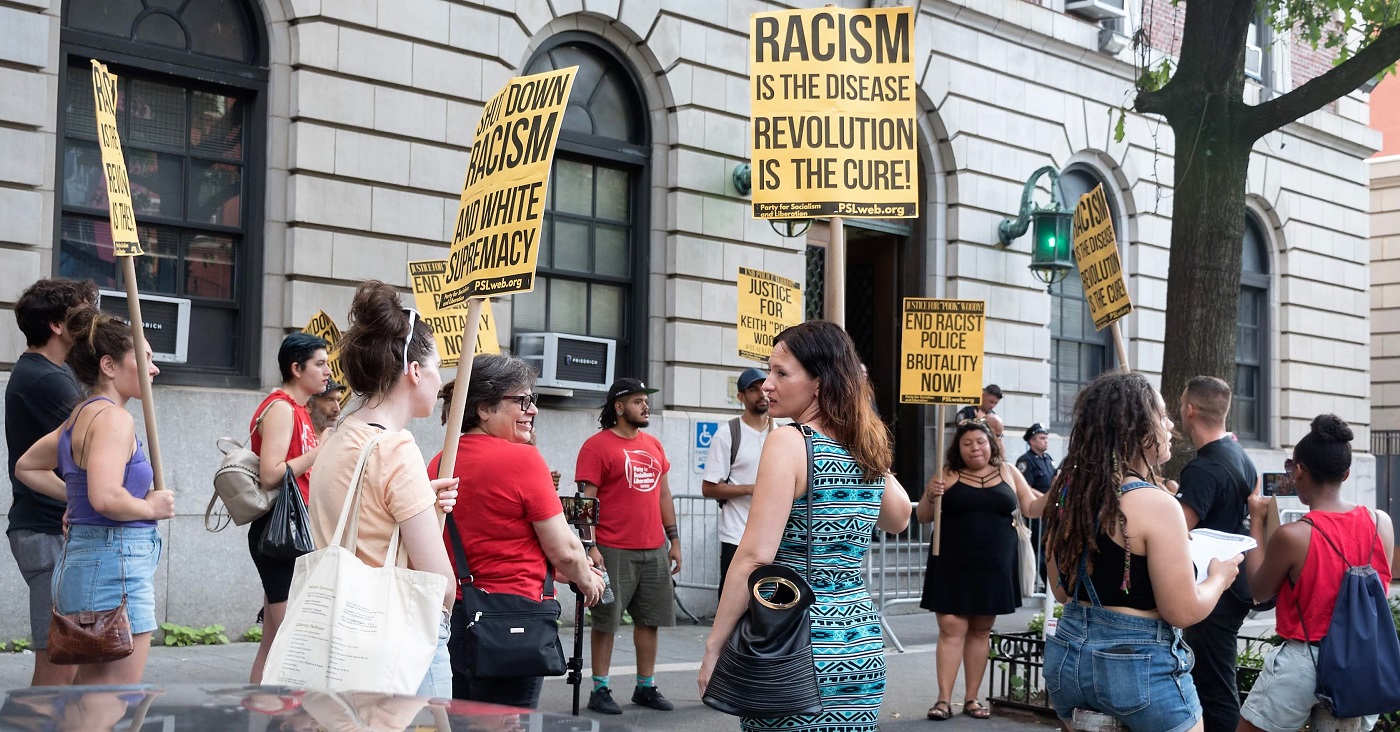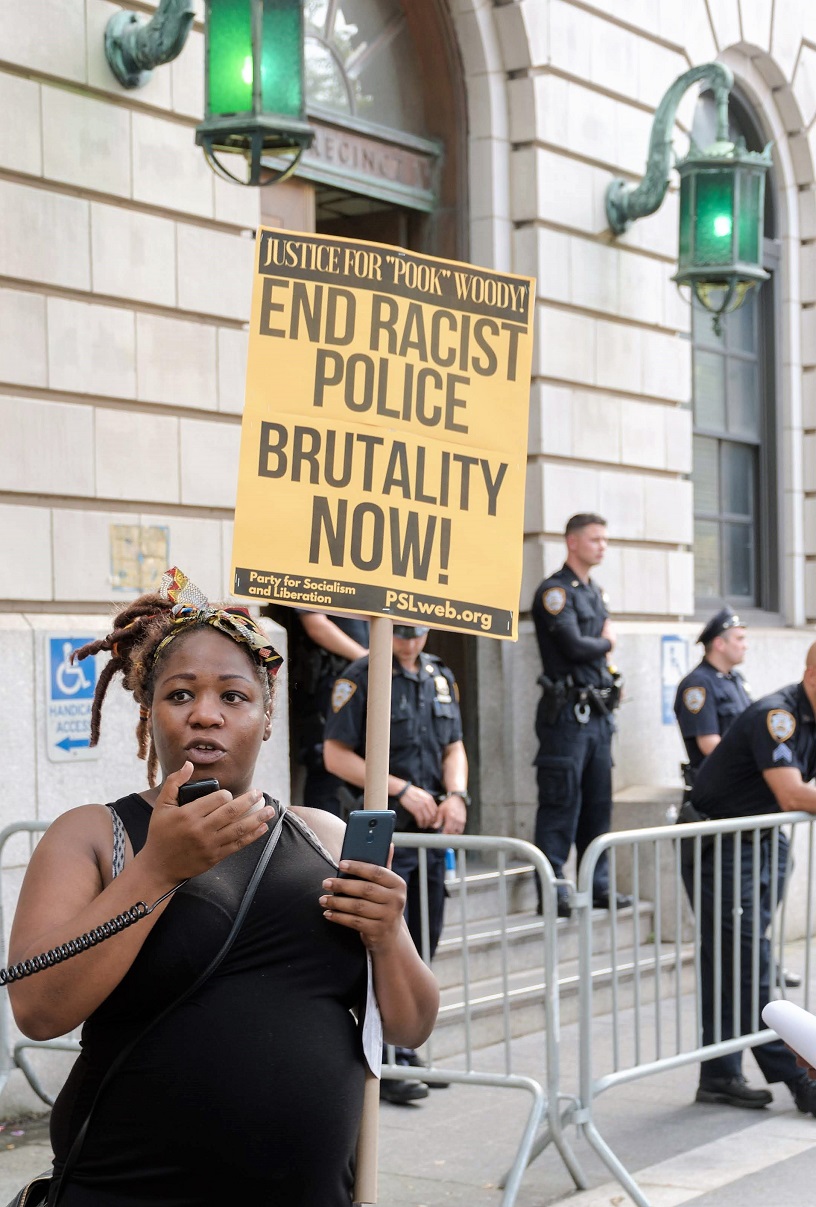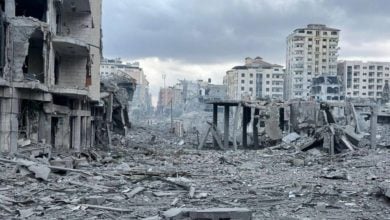
Passerbys blared their horns and cheered. Community members stopped to listen and pick up flyers. What was the occasion? On the sunny afternoon of Aug. 5, Party for Socialism and Liberation members stood on the steps of the 32nd Precinct of the New York City Police Department to protest their harassment of local Harlem youth. They rallied there to support Keith “Pook” Woody, a Black man who survived a recent violent attack by this very precinct.
On July 16, at the Lincoln projects, officers from the precinct arrested Woody. They were filmed dragging his unconscious body and dropping it next to a waiting car. In the footage, which was posted to Facebook, many of Woody’s neighbors can be heard urging police to call an ambulance and shouting “He can’t even stand up!” and “He did nothing wrong!”
Although Woody was originally arrested for a parole violation, he now faces charges for resisting arrest and assaulting a police officer stemming from the police assault on him! He is currently incarcerated.
PSL members organized the rally after spending time in Woody’s neighborhood and talking to young people who live on his block. They described routine and regular harassment from the police, including stopping them while riding Citi Bikes and making unfounded accusations of theft.
Although she was working, and unable to attend the rally, Woody’s mother called organizers and asked them to speak at the rally on her behalf. She expressed gratitude for people outside of her family believing in her son, and understanding that the officer’s behavior was part of a larger pattern of police attacks on Black and brown people.

NYPD’s systematic brutality
The community’s reaction is unsurprising given the NYPD’s racist and violent history. Victoria Davis, the sister of Delrawn Smalls, spoke at the rally and compared Woody’s case to what happened to her brother. The unarmed Smalls was murdered by off-duty NYPD police officer Wayne Isaacs on July 4, 2016. After the six-week trial, Isaacs was acquitted and allowed to return to his job, even receiving raises and overtime pay.
This culture of violence and impunity, according to Davis, was behind the treatment of Woody as well. In a powerful speech, she said the police “weren’t hired to protect and serve… they were hired to do exactly what they were doing: beating Black and brown people and killing them at alarming rates… The interaction that Keith had with the police could have easily resulted in his death.”
In addition to comparisons to other examples of NYPD murders like Deborah Danner and Saheed Vassell, Woody’s treatment bears chilling resemblance to that of Freddie Gray, a Black man who was assaulted by the Baltimore Police Department and fell into a coma and later died after being transported in a police van. Gray was one of 1,152 of people killed by police in 2015, 36% of whom were Black, despite African Americans being only 13% of the population.
History of white supremacist violence
PSL member and organizer for the Poor People’s Campaign Juan Peralta provided an historical context for the police’s abhorrent behavior. “We must remember that the police are a racist institution. The forces that were used to stop slaves from running away became the police force. The civil rights movement was suppressed and oppressed by the police force. When people of color fight for any rights, the police is the force sent to oppress them.”
He explained the police’s role in the criminalization of poverty. He further explained the police’s role in the criminalization of poverty, “Crime happens because people have very little option on how to thrive. Our country tells us that money is that only thing that gives us value, but then we are not given any options. People of color have always been suppressed and oppressed. There were laws that said people of color could not live in certain states, work in certain areas.” So after hundreds of years, he said, the only thing some of us had left was crime. “And then they oppressed us for trying to meet their standards.”
Many of the police officers arresting Woody were people of color. Justice Center organizer Monica Cruz explained that the white supremacist roots of the police department go beyond the identities of individual officers. “Once they join the police force and put on those badges and uniforms, they have the power to oppress our communities and play an agent in white supremacy… simply reforming the police won’t work. We need to create a new system.” Cruz emphasized relying on fellow community members for safety instead of the police.
Connection to Gentrification
East Harlem Preservation leader Marina Ortiz connected police brutality to rezoning and gentrification. “This country is founded on the violent displacement of people of color and we are still experiencing that every day. We are being pushed out of our communities that we have spent generations creating. El Barrio, Harlem… we’re being pushed out, shuffled around… in some cases, into jail, into coffins.”
Almost all of the neighborhoods targeted for rezoning in Mayor Bill De Blasio’s housing plan are poor or working class communities of color. Gentrification can make the problem of police brutality worse. Ortiz said, “Here in New York City, there are a rash of 911, 311 calls from new ‘neighbors’ calling about every single thing we do… playing drums in the park, the ice cream truck.”
These calls can have deadly consequences for the residents of communities being gentrified. Saheed Vassell, an unarmed, harmless regular in Crown Heights, Brooklyn, well known by neighbors, was shot and killed by a police after multiple 911 calls were made about his behavior. Community members believe the calls were made by a gentrifier who did not know the community’s dynamic, or understand the cops have very different forms of policing for white and black people.
Greater Implications
PSL member Karla Reyes said, the cops “are not here to protect and serve us. They are here to protect and serve private property. They are here to protect and serve the rich, the landlords. They are always there when you are about to get evicted and refuse to move, but they’re never there to protect you from an eviction.”
Under a system where the cops operate to protect the ruling class exploitation of working people, their brutality and violence against the oppressed is inevitable. As community members we need to fight back, and work to establish new systems to keep each other safe.






